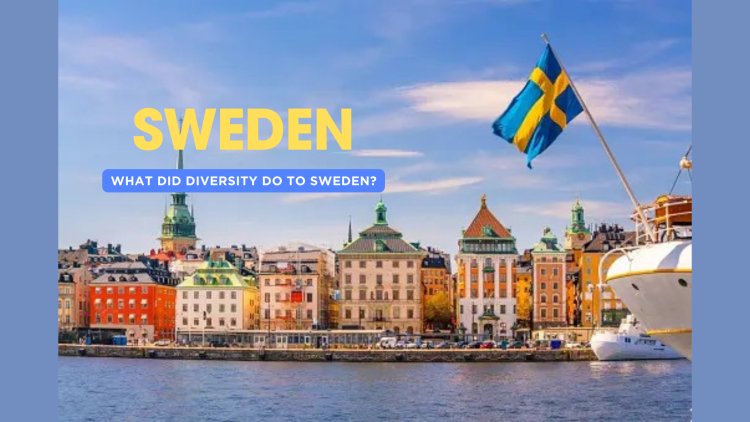What did diversity do to Sweden?
"Explore the impact of diversity and immigration on Sweden's society and economy. This article delves into Sweden's challenges and transformations due to its multicultural policies and the influx of non-European immigrants."

Sweden was often regarded as a very prosperous, developed country with a good standard of living and, above all, as a very peaceful society. It was even ranked among the top ten safest countries in the world. However, in recent years, Sweden has experienced one of Europe's highest rates of gun fatalities. Furthermore, hospital wait times are among the worst in Europe, and educational quality has decreased across the board, but the issue that concerns Sweden the most is crime and violence. In truth, Sweden was ready to deploy its military troops to deal with the wave of violence that had swept the country in September.
Swedish Prime Minister Ol Christon stated that Sweden has never seen something like this before and that no other country in Europe has either. The crisis is being pushed by gang turf fights, personal vendettas, and a large pool of available youth, the majority of whom are from immigrant groups arriving from neighbouring African and Middle Eastern nations like Syria, Iraq, Iran, and Somalia. Raa Maid, the boss of one of the most powerful gangs, came to Sweden as a newborn in 1986 after his parents escaped Iraq. So the questions are: Why is multiculturalism ruining Sweden, and why is immigration effective in other affluent nations but failed in Sweden before World War II? From 1871 until 1940, Sweden was a linguistically and culturally homogenous country. The average number of immigrants each year was 6,000, with the majority coming from Germany, Denmark, and Norway. However, in recent decades, multiculturalism has entered the political mainstream in Sweden, and the country has begun to accept a substantial number of refugees from outside Europe, making it one of the nations with the highest proportion of non-European immigrants in relation to its population.
Between 1985 and 2015, the proportion of immigrants of non-European backgrounds climbed from 2% to 15%. Sweden's population grew at a pace of more than 1% each year between 2015 and 2019, well above the average for developed nations. At first glance, this appears to be a very favourable development, as most European countries are experiencing the impacts of an ageing population. On the one hand, there are fewer individuals of working age, which means that fewer and fewer workers must support an increasing number of retirees; on the other hand, as the population ages, more people seek increasingly sophisticated and costly health services and treatments.
As a result, one of the techniques used by wealthy countries to adjust to their aging populations is to recruit immigrants. However, this technique did not work in Sweden since many of the working-age immigrants simply do not work; in other words, since Sweden transitioned from an immigration policy centred on luring workers to an immigration policy based on refugees from very different cultures, this plan has not worked. Integration into the work market is difficult, and they end up excluded and reliant on government help. Historically, integrating immigrants into the Swedish labour market was not an issue because the majority of immigrants came from linguistically and culturally close nations, and the majority of employment was straightforward, with well-defined and repetitive activities. Unlike today's labour market, which places more expectations on education, language skills, and job experience, immigrants have historically had a high employment rate. While most immigrants nowadays struggle to integrate into Swedish society and find work, in 2015, the employment rate for persons aged 20 to 64 born in Sweden was 82.9%, while it was 53.6% for those born outside Europe. This translates into a significant number of immigrants or refugees in danger of long-term exclusion, and when a significant number of immigrants are unable to integrate into society or the job market due to language, educational level, or culture, That is when gangs emerge in communities, either to belong to a social group or to make money. As a result, it is not surprising that criminal gangs have an easy time recruiting young, marginalized immigrants, resulting in increased crime and violence in Sweden. Because the majority of crimes and murders occur in immigrant neighborhoods, former Swedish Prime Minister Magdalena Anderson remarked in 2022 that segregation has been allowed to go so far that Sweden now has two civilizations.
"We share the same nation but have quite different realities. We will have to review our prior facts and make difficult decisions since enormous immigration has inflicted high costs on Sweden, both socially and economically. Sweden's central bank concluded that the enormous influx of immigrants in 2015, the year the country took in 163,000 refugees, resulted in a 1% decrease in GDP per capita and a 2.2 percentage point rise in unemployment. As we can see, Sweden's aim to be open and multicultural, welcoming immigrants from Africa and the Middle East, effectively ended the country's social cohesiveness and pacifism. One can believe that the large number of migrants arriving in Sweden is mostly the result of external circumstances."
A nation with Sweden's isolated geographical location and two neighbors Finland and Norway, on the other hand, has considerable control over the quantity of migrants coming. As a result, the number of asylum seekers in Sweden is mostly determined by political decisions to loosen protection and border control.
Furthermore, while Sweden is not compelled to give refugees permanent status, it frequently does so for humanitarian reasons. Other nations, such as Greece, Italy, Spain, or the United States, have problems regulating their borders, but whether Sweden wishes to accept more or fewer immigrants is primarily a political concern. On the contrary, some nations, such as Australia and Canada, take tens of thousands of immigrants each year, but their immigration is based on job and labour market demands. Immigration is substantially more successful since the immigrant must go through a lengthy process to get permanent status. Those who enter as students, for example, must pay for their education, get private health insurance, and seek permanent residency. They must show that they speak the language and have the appropriate experience and qualifications to formally enter the work market. In this way, the contribution of immigrants to the advancement of the country is made more obvious. On the contrary, an immigration strategy that gives citizenship to a large number of low-skilled immigrants merely results in the creation of welfare recipients.
In other words, in a world of billions of destitute people, a rich nation like Sweden, with 10 million residents and ample state benefits, cannot have uncontrolled immigration. Otherwise, it would attract immigrants who are more driven by state subsidies than by a job. Milton Friedman, a Nobel laureate in economics, stated that a society cannot have unrestricted immigration and a state that guarantees every inhabitant a set minimum amount of income regardless of whether they work or not. The present Swedish government is undertaking a series of measures aimed at strengthening borders and reducing the number of refugees accepted by the European Union, recognising that most crime occurs among immigrants and that completely disadvantaged groups are being established.
However, of Sweden's 10 million residents, 2 million were born abroad, with nearly 200,000 coming from Syria and 146,000 from Iraq, despite the fact that they are already Swedish. Citizenship means they may now vote, and having access to the ballot box allows them to vote for policies that benefit their immigrant communities in the future. So, regardless of how restrictive current policies are to allow fewer immigrants, Sweden will have to pay the repercussions of having implemented inclusive policies for so long.
Thanks for reading



 admin
admin 










